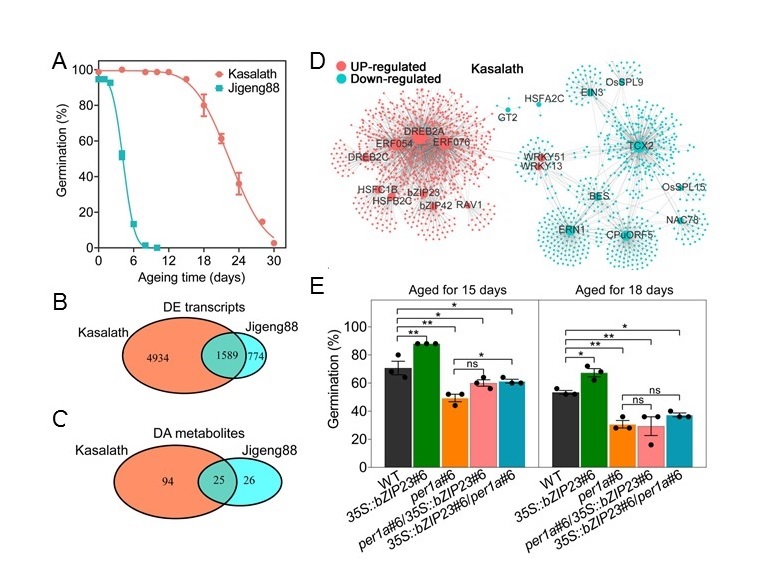How can crop seeds age more slowly and live longer? In a recent study published online in PNAS, researchers uncovered a gene network mechanism underlying the regulation of rice seed vigor.
Seed vigor refers to the ability of seeds to germinate and retain their germination potential during postharvest storage, with critical implications for seed quality and germplasm preservation.
The researchers, led by Dr. SONG Xianjun from the Institute of Botany of the Chinese Academy of Sciences, found that the transcription factor bZIP23 and the peroxiredoxin-coding gene PER1A function as a bZIP23-PER1A module that helps control seed vigor.
Cultivated rice, a model monocot plant, is an important crop that feeds over half the world’s population. In this study, the researchers evaluated seed vigor in cultivated rice and identified two cultivars with huge phenotypic differences, Kasalath and Jigeng88. The scientists subsequently used new high-throughput RNA sequencing data to search separately for differentially expressed genes in the cultivar seeds and then compared the seeds’ transcriptome profiles.
They also compared the broadly targeted LC-MS/MS-based metabolic profiles of the two seeds. “We found that various biological pathways and metabolic processes are key factors affecting the trait differences,” said Dr. SONG.
According to co-expression regulatory network analysis, several transcription factors, such as bZIP23 and bZIP42, are significant nodes in the network.
The researchers observed that transgenic seeds of overexpression of bZIP23 enhanced seed vigor, whereas knocking the gene out reduced seed vigor. In addition, loss of bZIP42 function reduced seed vigor. Similarly, they found that PER1A encodes a protein involved in reactive oxygen species detoxification as an active regulator of seed vigor.
Coincidently, they demonstrated that either bZIP23 or bZIP42 could directly bind to the promoter and significantly activate the expression of PER1A. Furthermore, genetic evidence indicated that bZIP23 functions in a common pathway with and acts upstream of PER1A to regulate seed vigor.
The study sheds light on the control of rice seed vigor and identifies a novel bZIP23-PER1A-mediated detoxification pathway that enhances seed vigor and provides potentially useful targets for improving crop quality.

The bZIP23-PER1A module contributes to rice seed vigor control.(Image by IBCAS)
Article Link: https://doi.org/10.1073/pnas.2026355119
Contact:
SONG Xianjun, Institute of Botany, Chinese Academy of Sciences
Email:songxj@ibcas.ac.cn
How can crop seeds age more slowly and live longer? In a recent study published online in PNAS, researchers uncovered a gene network mechanism underlying the regulation of rice seed vigor.
Seed vigor refers to the ability of seeds to germinate and retain their germination potential during postharvest storage, with critical implications for seed quality and germplasm preservation.
The researchers, led by Dr. SONG Xianjun from the Institute of Botany of the Chinese Academy of Sciences, found that the transcription factor bZIP23 and the peroxiredoxin-coding gene PER1A function as a bZIP23-PER1A module that helps control seed vigor.
Cultivated rice, a model monocot plant, is an important crop that feeds over half the world’s population. In this study, the researchers evaluated seed vigor in cultivated rice and identified two cultivars with huge phenotypic differences, Kasalath and Jigeng88. The scientists subsequently used new high-throughput RNA sequencing data to search separately for differentially expressed genes in the cultivar seeds and then compared the seeds’ transcriptome profiles.
They also compared the broadly targeted LC-MS/MS-based metabolic profiles of the two seeds. “We found that various biological pathways and metabolic processes are key factors affecting the trait differences,” said Dr. SONG.
According to co-expression regulatory network analysis, several transcription factors, such as bZIP23 and bZIP42, are significant nodes in the network.
The researchers observed that transgenic seeds of overexpression of bZIP23 enhanced seed vigor, whereas knocking the gene out reduced seed vigor. In addition, loss of bZIP42 function reduced seed vigor. Similarly, they found that PER1A encodes a protein involved in reactive oxygen species detoxification as an active regulator of seed vigor.
Coincidently, they demonstrated that either bZIP23 or bZIP42 could directly bind to the promoter and significantly activate the expression of PER1A. Furthermore, genetic evidence indicated that bZIP23 functions in a common pathway with and acts upstream of PER1A to regulate seed vigor.
The study sheds light on the control of rice seed vigor and identifies a novel bZIP23-PER1A-mediated detoxification pathway that enhances seed vigor and provides potentially useful targets for improving crop quality.

The bZIP23-PER1A module contributes to rice seed vigor control.(Image by IBCAS)
Article Link: https://doi.org/10.1073/pnas.2026355119
Contact:
SONG Xianjun, Institute of Botany, Chinese Academy of Sciences
Email:songxj@ibcas.ac.cn
